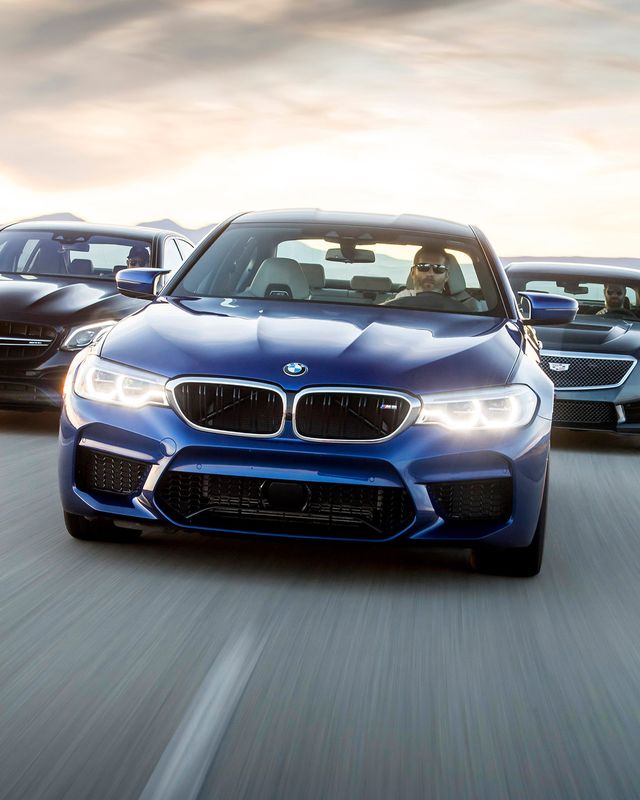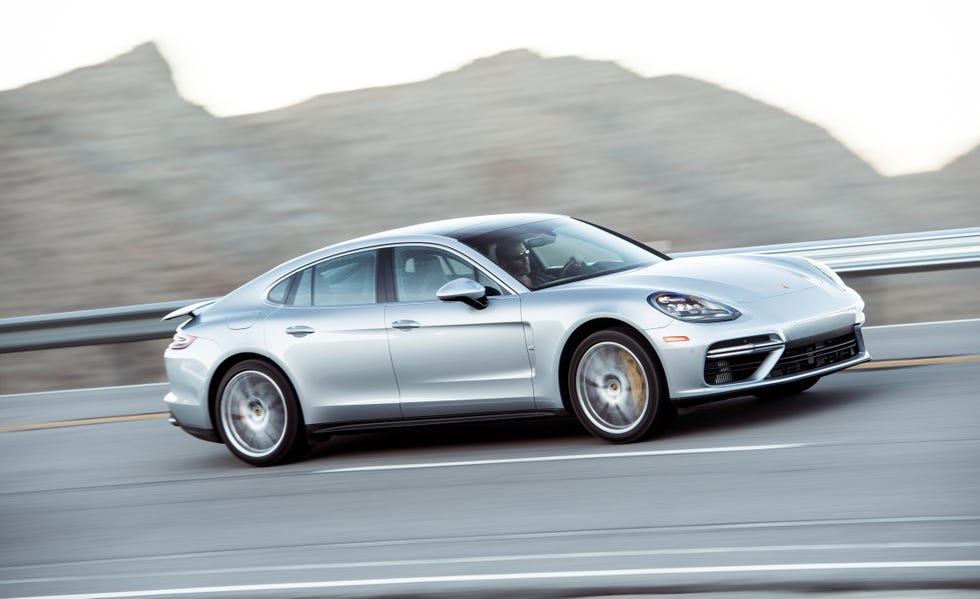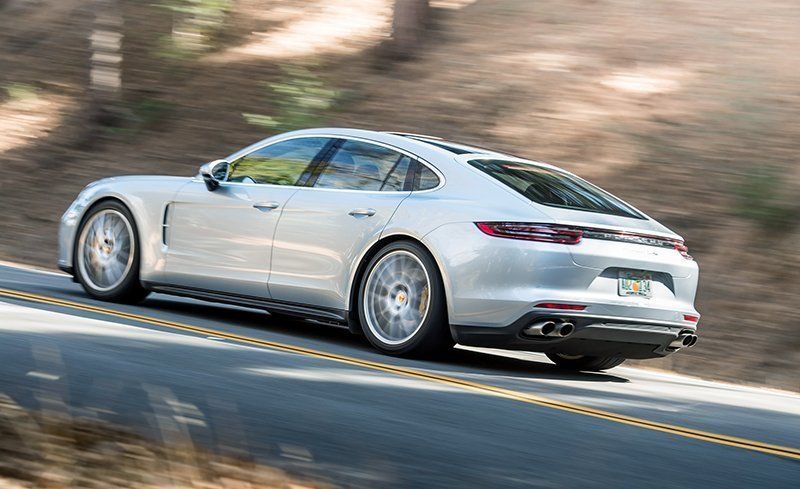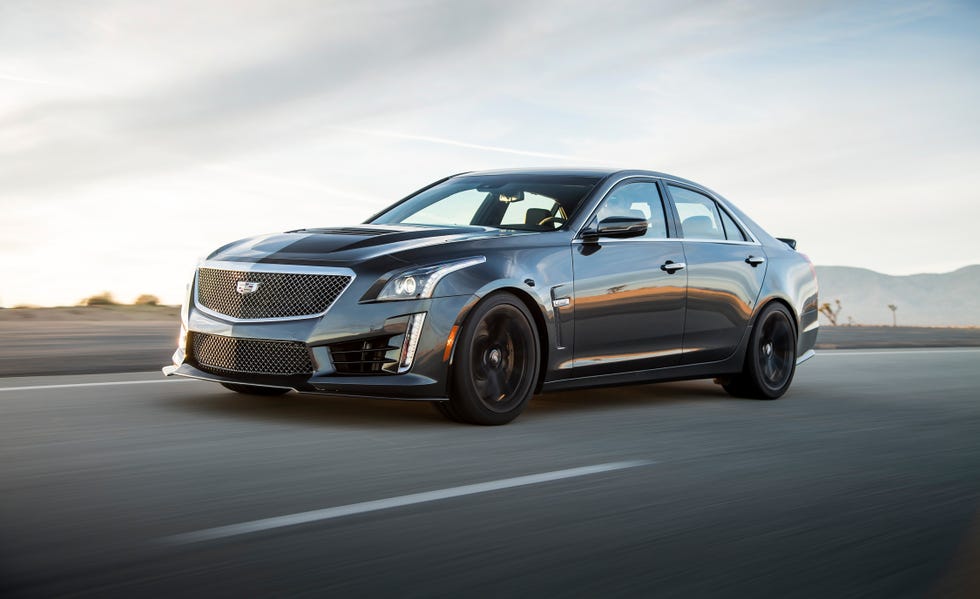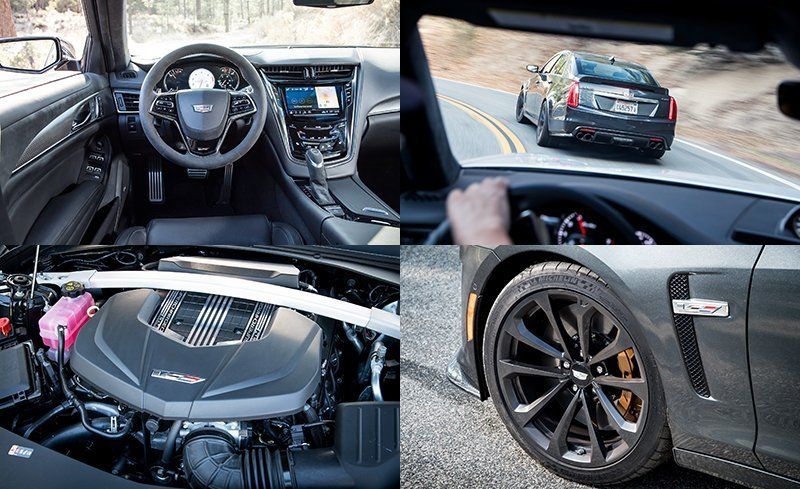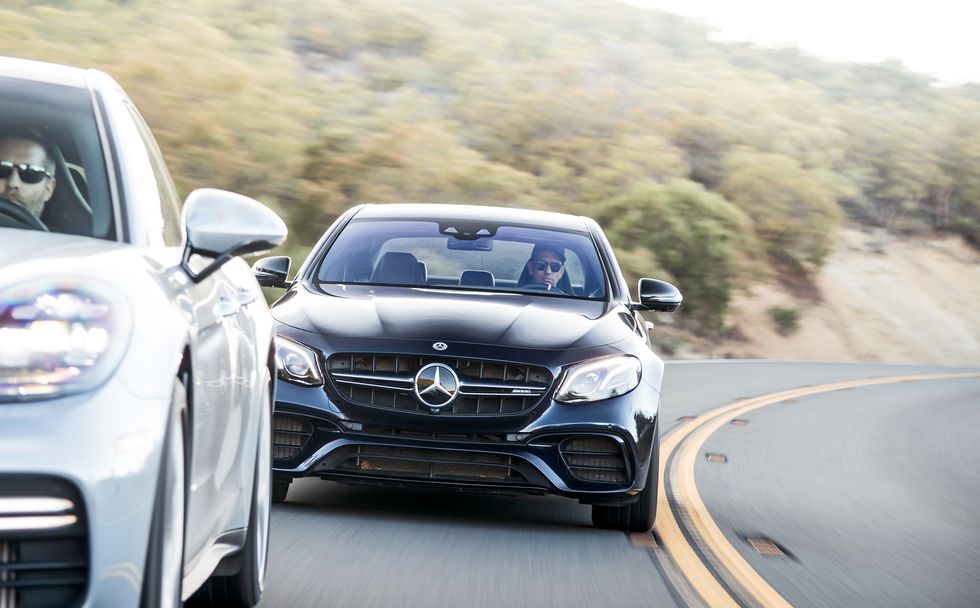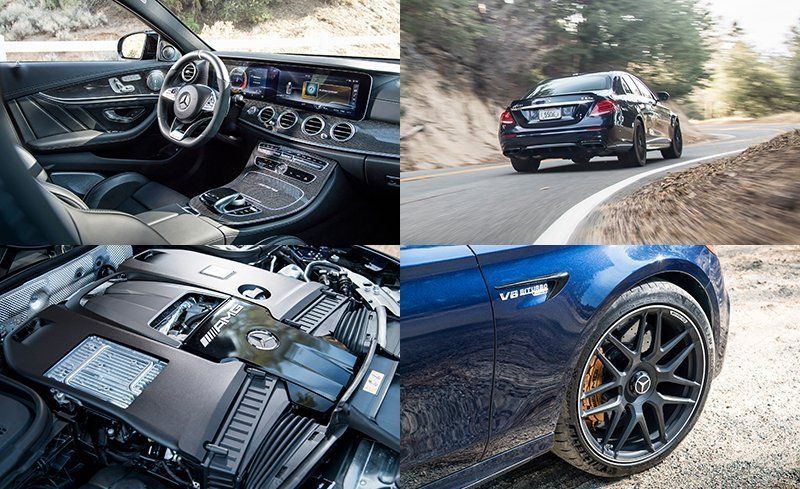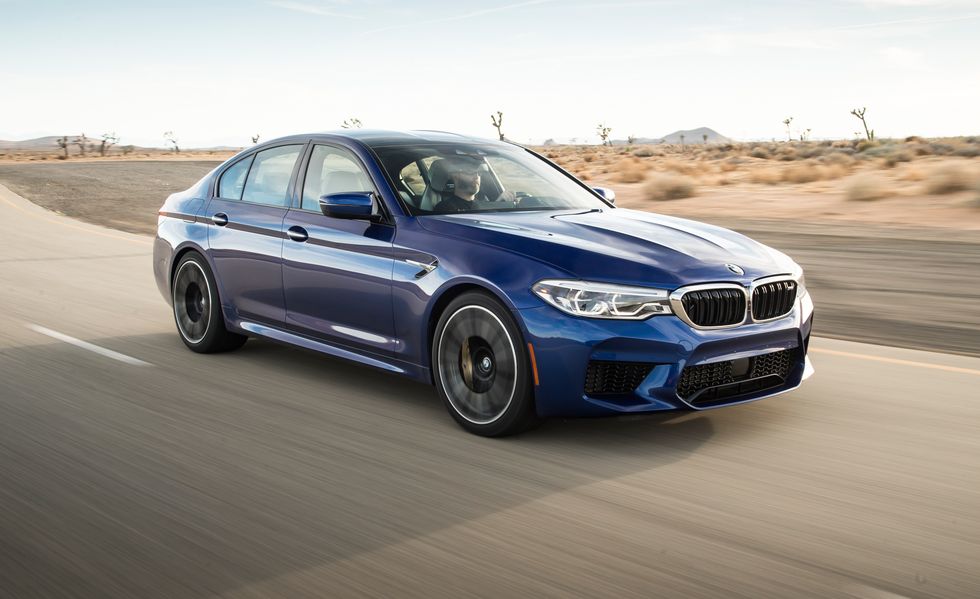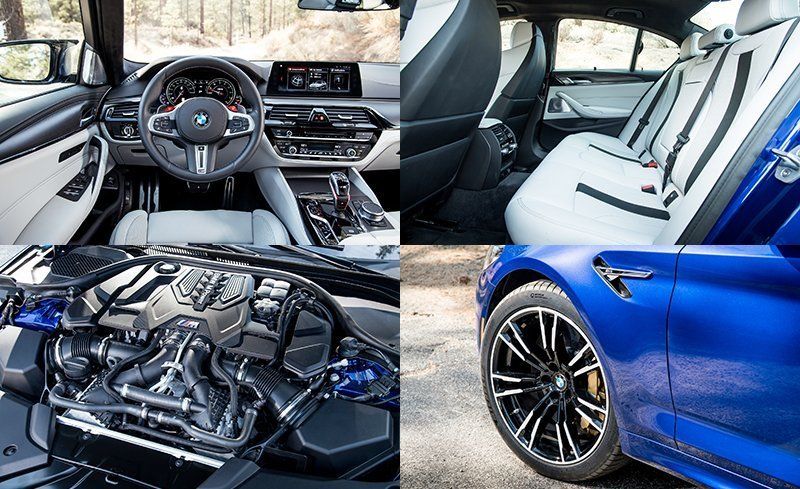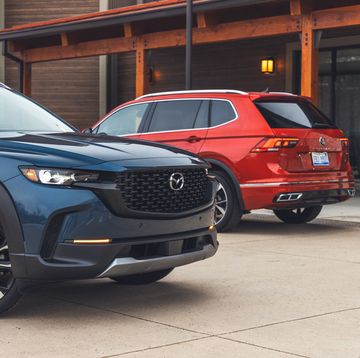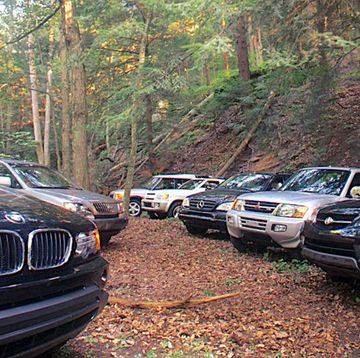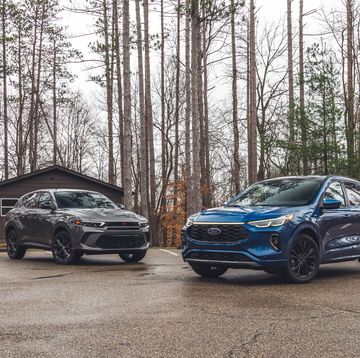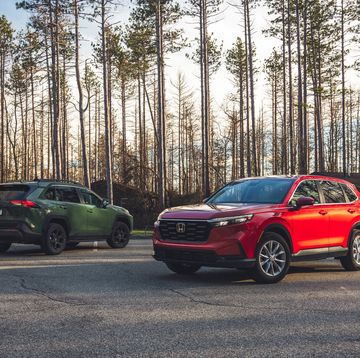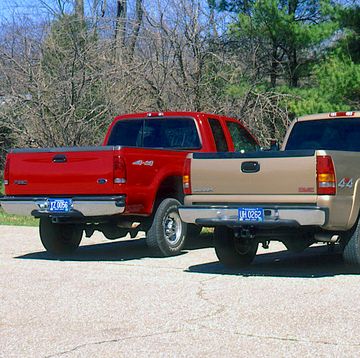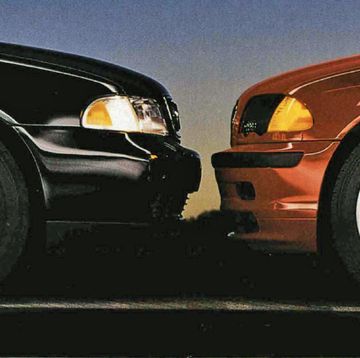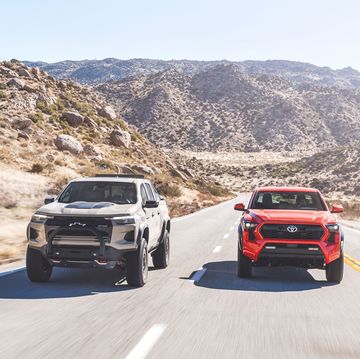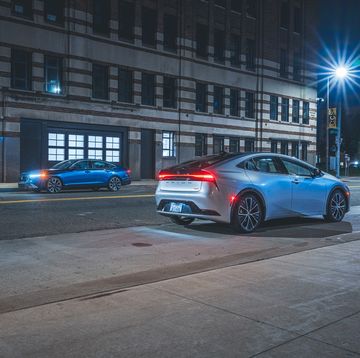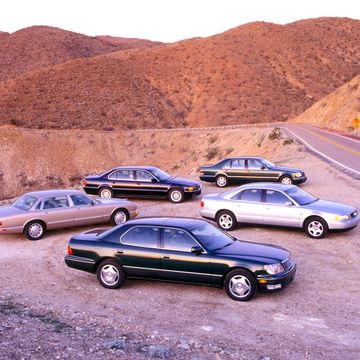From the April 2018 issue of Car and Driver.
Our test of 600-hp cars nine years ago looked very different from this one. Fenders bulged. Eight-, 10-, and 12-cylinder engines boomed. Hoods stretched to the horizon—except for that of the Italian, which carried its engine behind the cockpit. Because nine years ago, rounding up four cars with 600 horsepower meant coming face to face with rare and exotic sporting machines. We called them “the pinnacle of the automotive food chain.” They were a Chevrolet Corvette ZR1, a Dodge Viper SRT10, a Lamborghini Murciélago LP640, and a Mercedes-Benz SL65 AMG Black Series. It was 2009, and as the economy cratered and stiff fuel-economy mandates brewed, it was tempting to assume that the halcyon days of horsepower would soon be behind us.
It doesn’t appear as if automakers plan to cut us off anytime soon, though. When 600 horsepower seems unexceptional, you know you’re living in exceptional times. Packaged as it is for this comparison test—in four-door bodies, produced exclusively by blown V-8s, and paired with automatic transmissions—600 horsepower today looks markedly less exotic than it did back in 2009. But don’t be fooled—this much power will always blow your mind.
The BMW M5 is the newest in the set, and while it looks familiar, inside and out, it features two notable format changes: An eight-speed automatic transmission has taken over for the six-speed manual and seven-speed dual-clutch offered in the prior model, and standard all-wheel drive promises to shrink acceleration times. A rear-wheel-drive mode allows drivers to appreciate how masterfully all-wheel drive wrangles the full might of the 600-hp 4.4-liter V-8, particularly since it’s only available once stability control has been fully defeated. M5 pricing starts at $104,595 and runs $127,295 as equipped for our test, with the $4000 Executive package (soft-close doors, four-zone climate control, massaging and heated front seats, plus heated rears, among other equipment) making the M5 as lavish as it is sporting.
Cadillac’s 640-hp CTS-V is the outlier, nestling a supercharger in the valley of its V-8, where everyone else stuffs two turbochargers, and delivering torque to only the rear wheels. It’s also the value play, as it’s the sole car here that can be bought for five figures. The Caddy’s price, however, pushes to $102,935 with big-ticket options such as Recaro performance seats ($2300), the performance data and video recorder ($1600), the Luxury package ($2500), and an exterior carbon-fiber package ($6250). The price is kept in check, at least in part, because Cadillac doesn’t offer carbon-ceramic brakes, an option that costs between $8500 and $8960 on the three other cars assembled.
Mercedes began sending torque to both the front and rear axles of its E63 for the 2014 model year. Naturally then, the big innovation of the new-for-2018 E63 S 4MATIC is . . . rear-wheel drive. As on the M5, the E63’s two-wheel-drive mode can’t be unlocked until all the electronic safety nets have been cut, at which point the 603-hp Mercedes reverts to old habits, i.e., butchering tires in burnouts and drifts. Our $134,600 test car includes upgraded front seats ($1320), forged 20-inch wheels ($1700), an active exhaust ($1250), an advanced lighting package ($1500), and additional insulation in the body and glass ($1100) as part of its $29,205 in extras.
We also have the second generation of Porsche’s Panamera Turbo. The Panamera 2.0 arrived for 2017 cured of its scoliosis and looking quite handsome. Porsche’s passenger car seats four and swallows cargo via its hatchback. The options list is short on this particular Porsche, but that doesn’t make it inexpensive. Its $25,375 in add-ons are concentrated around performance-enhancing equipment such as the Sport package with launch control, four-wheel steering, and two-mode exhaust ($5580); active anti-roll bars ($5000); and carbon-ceramic brakes ($8960). As tested, this one costs $173,325, and yet with a mere 550 horsepower, the Panamera is the noodly-armed kid that threatened to undo our gathering of four 600-hp brutes for this comparison test.
But if you could turn the camera around in that opening image, you’d see that things are so heady in 2018 that our chase car compensates for the Porsche’s 50-hp deficit. Armed with 603 horsepower in its own Mercedes-AMG E63 S 4MATIC wagon, our photo team had no excuse for falling off the pace during this test. In fact, we were so smitten by the longroof’s hard-charging performance, innate practicality, and dashing looks that we briefly considered naming it the winner of a comparison it didn’t compete in.
We did not extend such consideration to the Audi RS7, which needed to make an appearance if it was going to defend its 2013 victory over the BMW M6 Gran Coupe and the Mercedes-Benz CLS63 AMG S. Audi introduced an RS7 Performance for 2016 that pushes the twin-turbo 4.0-liter V-8 from 560 horsepower to 605, but the company was in the midst of launching the next-gen A7 and didn’t have an RS7 for this test.
Just as we did nine years ago, we concentrated our power in Southern California. Where writhing mountain highways spill into desolate desert, we ran these heavy hitters hard and fast to determine which car actually earns the right to wear its golden brake calipers.
Fourth Place: Porsche Panamera Turbo
In the way it corners, the Porsche Panamera Turbo is simultaneously remarkable and disappointing. Active anti-roll bars work with the standard air springs and adaptive dampers to hold the body virtually flat in corners and float it over rough pavement. Those attributes combine for handling that is unperturbed by midcorner bumps, and by remaining so steadfast and fluid, the Porsche largely hides that it’s a 4682-pound porker.
HIGHS: Corers flatly, rides gracefully.
LOWS: Doesn't steer like a Porsche, hopeless ergonomics, absurdly expensive.
Yet on narrow canyon roads that leave little room for error, the Panamera feels every inch as wide as its 76.3-inch beam suggests. As the four-wheel-steering system muddles the intended trajectory, the driver compensates with steering that is uncharacteristically light. Its sense of vagueness lingers even as you accumulate seat time. Relative to the pointy Cadillac and the playful BMW, the Porsche comes off as a little numb, even imprecise.
Drunk on power from driving the competition, one editor repeatedly and earnestly asserted that the Panamera Turbo wants for thrust. He wasn’t entirely wrong. With its swollen weight-to-power ratio, the Porsche certainly doesn’t pull as hard as the others in passing maneuvers. Its 3.0-second zero-to-60 run is largely a testament to the launch-control scheme that spins the engine to 5000 rpm before firing the Turbo down the barrel.
The latest Porsche infotainment system features a volume roller hidden out of sight ahead of an electronic shifter, surrounded by hard-to-target haptic “buttons.” And there are too many critical controls packed into the convoluted menus lurking within the wide touchscreen. The system pulls your eyes off the road and your attention away from driving, and it makes Cadillac’s CUE look downright sensible. Living with it on a daily basis may require use of an effective blood-pressure medication.
But ultimately, this supersedan didn’t get fourth place because of its infotainment system. At $38,725 more than the next most expensive car in the group (the Mercedes), this Panamera costs a whole heap of money and includes relatively little in the way of equipment. And this is one Porsche that doesn’t compensate with superior driving dynamics. If it’s a four-seat $170,000 Porsche you seek, we recommend the 911 Turbo.
THE VERDICT: Don't call it a four-door 911.
2017 Porsche Panamera Turbo
550-hp V-8, 8-speed dual-clutch automatic, 4682 lb
Base/as-tested price: $147,950/$173,325
C/D TEST RESULTS
60 mph: 3.0 sec
100 mph: 7.4 sec
150 mph: 18.2 sec
1/4 mile: 11.3 @ 123 mph
Braking, 70–0 mph: 153 ft
Roadholding, 300-ft-dia skidpad: 1.00 g
C/D observed fuel economy: 13 mpg
Third Place: Cadillac CTS-V
Unable to make use of its full 630 pound-feet of torque in first gear, the Cadillac CTS-V is the unwitting poster child for BMW’s and Mercedes’ switch to all-wheel drive. Despite being the lightest and most powerful car here, the rear-wheel-drive Caddy churns out the slowest standing-start acceleration times, ceding a full second to the M5’s zero-to-60 blitz.
HIGHS: The way it steers, the way it turns, the way it rides.
LOWS: Can't put the power down, grim interior.
But we’d happily trade straight-line acceleration to move so swiftly through corners. The Michelin Pilot Super Sports cling to mountain asphalt, providing aggressive turn-in bite and dogged grip. Helped by what is perhaps the purest steering in a four-door, this long and narrow dart of a car lands at the apex corner after corner. At the track, the CTS-V’s dynamic excellence delivered the best handling numbers, with 1.01 g’s of cornering stick and a 46.4-mph run through the slalom.
The eight-speed automatic is neither as crisp nor as quick as the competition’s. The LT4 V-8, however, compensates with pushrods, a big supercharger, and even bigger displacement. Its laughable 11-mpg thirst is as charming as the characteristic tremor of a small-block at idle. Under acceleration, the chuff of the blower fills the cabin and drowns out the V-8 snarl.
That the CTS-V borrows the Corvette’s engine and apes its blissful handling is a virtue. That Cadillac’s interior designers apparently thought they were working on a Chevrolet is not. New for the 2014 model year, the CTS’s cabin already looks twice its age thanks to an overwrought design, unexceptional materials, and tortured ergonomics. The cramped back seat is a pseudosuede prison. The front camera (so you don’t crunch the carbon-fiber splitter in parking lots) offers the clarity of a kaleidoscope. Sure, the updated CUE infotainment system is much improved since its debut, but it won’t be acceptable until Cadillac replaces the often unresponsive haptic volume control with something that works more reliably. The Cadillac is the car to own if you commute to work on California’s Angeles Crest Highway. For the rest of us, though, it fails to live up to the expectations of a six-figure luxury car.
THE VERDICT: The car we want to drive, but not the car we want to own.
2018 Cadillac CTS-V
640-hp V-8, 8-speed automatic, 4168 lb
Base/as-tested price: $88,490/$102,935
C/D TEST RESULTS
60 mph: 3.8 sec
100 mph: 8.1 sec
150 mph: 20.1 sec
1/4 mile: 12.0 @ 121 mph
Braking, 70–0 mph: 148 ft
Roadholding, 300-ft-dia skidpad: 1.01 g
C/D observed fuel economy: 11 mpg
Second Place: Mercedes-AMG E63 S
“The E63 S is proof that the folks in Affalterbach are the rednecks of Europe.” That’s pretty high praise from executive editor Jared Gall, a man who regularly shoots groundhogs from the comfort of his bathtub. No doubt AMG would prefer we thought of its cars as more sophisticated than mere leather-clad hot rods. But that’s not going to happen as long as the company builds engines as awesome as this 603-hp V-8.
HIGHS: Monster engine, opulent cabin, Drift mode.
LOWS: Flinty ride quality, unbalanced handling.
The E63’s twin-turbo 4.0-liter bellows and barks until it howls and screams its way to 7000 rpm. Its 627 pound-feet of torque shove this sedan forward in any of the automatic transmission’s nine gears. The gearbox, which uses a clutch pack rather than a conventional torque converter, snaps off shifts and slingshots the 4579-pound Merc to 60 mph in 2.9 seconds. All-wheel drive can’t neuter an engine this potent, but that didn’t stop the Germans from indulging their inner Luke and Bo by including a rear-wheel-drive function called Drift mode.
There’s nothing backwoods about the AMG’s cabin, which contains enough carbon fiber to build a tandem bicycle. Each piece is meticulously sculpted and finished. The door panels flow gracefully into the dash, and the round climate vents rise out of trim pieces that seem to have the surface tension of water. Our only gripe about the plush cabin: The $1320 multicontour seats are misleadingly named, lacking the adequate contouring and padding to encourage us to spend much more than an hour in them.
Over expansion joints and cracks, the AMG’s Michelin Pilot Sport 4S tires slap at the road and drive shudders into the cabin. While it matched the CTS-V’s 1.01 g’s of lateral grip, the E63 S recorded the slowest average speed through the slalom cones. That’s the product of a more fickle chassis balance that succumbs to understeer and oversteer more readily than the other cars. On tightly wound mountain roads, the AMG’s front-end grip washes out early, and the heavy steering makes the E63 feel more ponderous than it is. AMG’s E63 S isn’t the one-dimensional bruiser it once was, but it’s still not the complete package that the BMW is.
THE VERDICT: A hooligan wearing a three-piece suit.
2018 Mercedes-AMG E63S 4MATIC
603-hp V-8, 9-speed automatic, 4579 lb
Base/as-tested price: $105,395/$134,600
C/D TEST RESULTS
60 mph: 2.9 sec
100 mph: 6.7 sec
150 mph: 15.9 sec
1/4 mile: 11.0 @ 128 mph
Braking, 70–0 mph: 153 ft
Roadholding, 300-ft-dia skidpad: 1.01 g
C/D observed fuel economy: 13 mpg
First Place: BMW M5
We were prepared for the F90 M5’s 150 to 200 pounds’ worth of all-wheel-drive hardware to give the 5-series yet another layer of insulating fat between driver and road. Instead, M engineers trimmed enough poundage elsewhere (note the standard carbon-fiber roof) that this M5 weighs about 100 pounds less than its predecessor.
HIGHS: Proper M-car handling, honeyed powertrain.
LOWS: Tall seating position, ludicrous hand waving, silly fake engine note.
The twin-turbo 4.4-liter V-8 is strong over the full sweep of the tach, quick to build boost off idle, and buttery smooth at its 7200-rpm redline. It’s paired with an eight-speed torque-converter automatic that offers the quick and satisfying action of the best dual-clutch transmissions, without any coarseness. The software guys writing the soundtrack still have work to do, though, as the engine note is blatantly flubbed, most noticeably in the flatulent simulated staccato that accompanies upshifts.
But don’t let theatrics taint reality, because there’s absolutely nothing artificial about the way the M5 moves. It claims the shortest stop from 70 mph at 147 feet. It harasses supercars with its 2.8-second rip to 60 mph. At 10.9 seconds and 129 mph in the quarter-mile, the 4288-pound M5 is only one-tenth of a second slower than the half-a-million-dollar Ford GT.
Wearing the smallest tire stagger in the test, the BMW delivers indefatigable front-end grip. It dives into corners with precision and deftness. The BMW’s maximum lateral grip (0.98 g) trails the rest of the group’s by a few hundredths—hundredths that you’ll never miss when you’re exploring the M5’s handling nuance on a squiggle of mountain road.
The body control of the BMW isn’t cinched as tightly as it is on the Cadillac or the Porsche, and that isn’t a bad thing. There’s information to be gleaned from the way the body bounds and leans: how much load individual tires are carrying and how the road camber is changing. This is the analog feedback loop that was notably absent in the sober previous M5. That car at times felt as large and aloof as a 7-series. The new one drives more like a grown-up M3.
The front buckets are seemingly infinitely adjustable and cross-country comfortable, although they sit quite high and all those motors and bladders make the seatback extra thick, which eats into the rear-seat legroom. Rich materials and impeccable build quality abound inside, although it appears that even BMW’s own designers are bored with the current long-in-the-tooth design motif. How else do you explain an infotainment system that can be controlled by waving a hand in the air? The luxury never left BMW’s M5, though. Now that the playful chassis is back in balance with a more potent engine, the M5 is again the king of the hill.
THE VERDICT: A fully alive sports sedan back from the dead.
2018 BMW M5
600-hp V-8, 8-speed automatic, 4288 lb
Base/as-tested price: $104,595/$127,295
C/D TEST RESULTS
60 mph: 2.8 sec
100 mph: 6.6 sec
150 mph: 15.9 sec
1/4 mile: 10.9 @ 129 mph
Braking, 70–0 mph: 147 ft
Roadholding, 300-ft-dia skidpad: 0.98 g
C/D observed fuel economy: 15 mpg

Eric Tingwall holds degrees in mechanical engineering and journalism, a combination he pursued with the dream of working at Car and Driver. While living his dream, he has cut car parts in half, driven into a stationary dummy car at 50 mph, lapped Virginia International Raceway in the hottest performance cars, and explained the physics behind the wacky, waving, inflatable, flailing-arm tube man.
